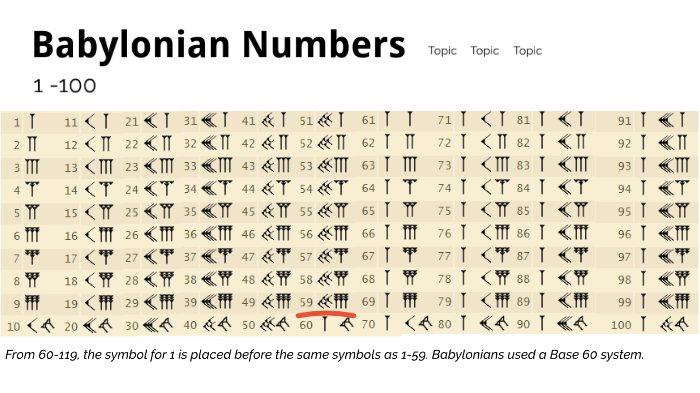

Welt des Orients 18: 26–42.įrahm, Eckart. Neues aus Uruk: Zur ‘Bibliothek des Iqīša’.

Revue d’Assyriologie 29: 11–19.įarber, Walter. Münster: Ugarit-Verlag.ĭe la Füye, Alotte. Les bibliothèques en Babylonie dans la deuxième moitié du I er millénaire av. Revue d’Assyriologie 29: 183–188.Ĭlancier, Philippe. Le calcul de la table mathématique AO 6456. Ham-sur-Heure: Comité Belge de Recherches en Mésopotamie.Ĭazalas, Général. In Actes de la XVIIe Rencontre Assyriologique Internationale, ed. La construction de la grande table de valeurs réciproques AO 6456. Journal of Cuneiform Studies 43–45, 71–87.īruins, Evert M. A table of 4th powers and related texts from Seleucid Babylon. A collection of rules for the prediction of lunar phases and of month lengths. Cambridge, MA: MIT Press.īrack-Bernsen, Lis, and Hermann Hunger. In Ancient astronomy and celestial divination, ed.
#187 IN BABYLONIAN NUMERALS ARCHIVE#
A new mathematical text from the astronomical archive in Babylon: BM 36849. Journal of Cuneiform Studies 22: 88–91.Īaboe, Asger. Two atypical multiplication tables from Uruk. Journal of Cuneiform Studies 19: 79–86.Īaboe, Asger. Some Seleucid mathematical tables (extended reciprocals and squares of regular numbers). Washington: Mathematical Association of America.Īaboe, Asger. Episodes from the early history of mathematics. It is based on a Sumerian (Third Dynasty of Ur) predecessor preserved in the Umma calendar of Shulgi (c. My source for this calendar is Wikipedia. Name: Araḫ Addaru Arku or Araḫ Makaruša Addari.In year 17 of the 19-year cycle, the intercalary month was named Araḫ Ulūlu – 𒌚𒆥 – Adar II Season – Winter – Qīt Šatti – The End – 𒌀𒈬 Known as: Month of Beginning (start of the second half-year).

Season – Mišil Šatti – Summer/Fall – The Middle – 𒁇𒈬 Season – Reš Šatti – Spring – The Beginning – 𒊕𒈬ĭuring this period, the first day of each month (beginning at sunset) is the day when a new crescent moon was first sighted-the calendar never used a specified number of days in any month. After no more than three isolated exceptions, by 380 BC the months of the calendar were regulated by the cycle without exception. In the cycle of 19 years, the month Adaru 2 was intercalated, except in the year that was number 17 in the cycle, when the month Ulūlu 2 was inserted. Until the 5th century BC, the calendar was fully observational, but beginning about 499 BC the months began to be regulated by a lunisolar cycle of 19 years equaling 235 months. The lunation of 29 or 30 days basically contained three seven-day weeks, and a final week of eight or nine days inclusive, breaking the continuous seven-day cycle. Tablets from the sixth-century BC reigns of Cyrus the Great and Cambyses II indicate these dates were sometimes approximate. On these days, offerings were made to a different god and goddess at nightfall to avoid the prohibitions: On these days officials were prohibited from various activities and common men were forbidden to “make a wish”, and the 28th was known as a “rest-day”. The chief deity of the Assyrians is assigned the surplus intercalary month, showing that the calendar originates in Babylonian, and not later Assyrian times.ĭuring the 6th century BC Babylonian captivity of the Hebrews, the Babylonian month names were adopted into the Hebrew calendar. In Iraq and the Levant, the Gregorian solar calendar is used with Arabic names of the Roman months replacing the Latin names.Ĭounting from the new moon, the Babylonians celebrated every seventh day as a “holy-day”, also called an “evil-day” (meaning “unsuitable” for prohibited activities). The year begins in spring, and is divided into reš šatti “beginning”, mišil šatti “middle”, and qīt šatti “end of the year”.
#187 IN BABYLONIAN NUMERALS PLUS#
The Babylonian calendar was a lunisolar calendar with years consisting of 12 lunar months, each beginning when a new crescent moon was first sighted low on the western horizon at sunset, plus an intercalary month inserted as needed by decree.


 0 kommentar(er)
0 kommentar(er)
